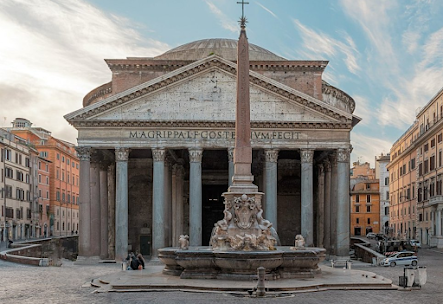history of concrete
Use of Concrete in Early History:
Pozzolana, a form of volcanic ash, was used by the Romans to
manufacture concrete in 300 BCE. The Pantheon's roof was completed in
125 CE, making it the biggest unreinforced concrete dome in the world at the
time. The Romans employed concrete throughout Europe until the Empire's
collapse in the fifth century.
Here is an example; With its massive unreinforced concrete dome, the Pantheon was constructed in 125 AD by Hadrian, the Emperor of Rome. At its highest point, 142 feet above the ground, the dome features a 27-foot aperture known as an oculus, measuring 142 feet in circumference. It was presumably constructed in situ by beginning above the outer walls and progressively adding thinner layers as one moved toward the center (Anon, n.d.).
Use of concrete in the modern world:
In the 1750s, British civil engineer John Smeaton was hired to build a lighthouse off the coast of Cornwall, which was an early example of a "modern" use of concrete. In 1759, Smeaton completed the construction of the Eddystone lighthouse by experimenting with Roman pozzolana to create a novel type of "hydraulic lime" that set underwater. Researchers refer to set concrete as having a high compressive strength because of its exceptional resistance to crushing. Its deficient tensile strength means that it is not very tolerant of being bent. Because of its relative tensile weakness and compressive strength, concrete was preferred by engineers of the 19th century for certain uses, such as constructing foundations.
In the 20th century:
"We’ve had the Stone Age, the Bronze Age, and the Iron Age. From the dawn of the twentieth century … is the Concrete Age." J Winn, ‘The Advent of the Concrete Age' (1906)
The 20th century was the concrete era. Hennebique's Weaver's Mill technique was used to build nearly 40,000 structures in the ten years that followed. Since then, there has been no indication that the floodgates made of concrete will close. This seemingly miraculous material was used for flyovers, roads, bridges, dams, tunnels, and docks.
REFERENCES:
- Building the modern world: Concrete and our environment | Science Museum. [Online] Science Museum. Available from : https://www.sciencemuseum.org.uk/objects-and-stories/everyday-wonders/building-modern-world-concrete-and-our-environment.
The History of Concrete. Available from : https://www.nachi.org/history-of-concrete.htm.






Mouad, we have discussed the use of concrete - I don't think this should be part of your material research and in line with DMU's sustainability policy this would not be acceptable on your Undergraduate.
ReplyDeleteThere are very good alternatives, I recommend Ferrock (see link here for alternatives: https://www.bricsys.com/en-gb/blog/alternatives-to-concrete-in-construction)